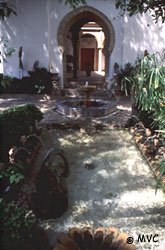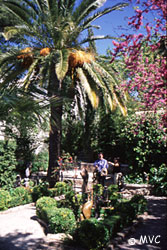 |
| Ronda Mondragón Palace |
Ronda's loveliest enclosed space is the Mondragón palace, the heavily renovated and part-modernised remnants of what once was the palace of the Moorish ruler Abbel Mallek, or Abomelic, son of the king of Morocco. The palace is tiny, but much detail remains, in the Mudejar ceilings, some original tiling, and the balconied inner courtyards. The best feature, however, is the remaining water gardens, miniature relatives of the Generalife at Granada, even though one is now covered in very Francoish sixties concrete. (The palace was in ruins before its last renovation.) The water gardens sit on the very edge of the town cliffs, and often host outdoor sculpture shows. It is also very popular for weddings of any (or no) denomination. The upper floor houses the town museum and a permanent display of local natural history, and the building's remaining spaces are home to Ronda's main languages school.
In contrast to the Casa del Rey Moro, the Palacio de Mondragón has a genuine Moorish pedigree. If any building in Ronda deserves to be called the house of the Moorish king, this is it. Some say it was built for the same King Abomelik, or Abomelic, or even Abb el Malik, responsible for the construction of the water mine, but its generally accepted construction date of 1314 would appear to rule that out. Abomelik (to select one spelling at random), son of Abul Hassan, sultan of Morocco, Emperor of Fez, presided over what was, at least in Moorish eyes, Ronda's golden age. Yet in spite of its splendour, his rule was over in the blink of an eye. He crossed the straits at the behest of his father around 1330, scored a resounding success in battle at Gibraltar in 1333, and died five years later while fighting the forces of Alfonso XI close to Jerez de la Frontera. So if the palace was not built especially for him, he may well have lived in it
Book your stay in Andalucia Now!
It was certainly the home of the ill-fated Hamet el Zegri, Ronda's last Moorish governor, though he might not recognise it today. It has undergone major changes and additions over the years, the first ordered by the catholic monarchs, Ferdinand and Isabella, who stayed there during the 1490s. The present garden is a later addition, and the front gallery is modern. More significantly, the entire outer building surrounding the inner courtyards (where el Zegri would certainly still feel at home) dates only from the 18th Century.
That facade is still genuinely impressive. Two small towers flank a superb doorway through which visitors pass to gain entrance to a building which, centuries after Hamet el Zegri left it for the last time still speaks proudly of a vanished glory.
 |
|
Ronda Mondragón Palace
|
The palace is now a museum devoted to the history and pre-history of the area. Each of the exhibits is accompanied by explanatory posters in Spanish and English, although it must be said that the English translations are occasionally ungrammatical, and contain numerous spelling mistakes. It is difficult to understand why. This part of Spain is home to thousands of highly literate British expatriates, any of whom could have spotted the errors and corrected them before they were committed to print. It would be easy to say that the errors lend the museum an endearing charm, like the sound of Maurice Chevalier wrapping his Gallic accent around the words of an English song, but that would be unnecessarily patronising. The English translations could and should have been proof-read by a native English speaker.
That being said, the museum is a fine adornment to a building that could certainly stand alone as a first-class tourist attraction.
Opening Hours Monday to Friday 10.00-13.45 and 15.00 to 18.00 Saturday and Sunday 10.00-15.00 Entrance 2
GPS Location: 36º 44' 16"N 5º 09' 59"W View on Google Maps